How the Camel got his hump Summary, Explanation and Difficult words meaning
NCERT Class 8 English It so Happened Book
Updated for CBSE Class 8 2025-25 Session
How the Camel got his hump Class 8 English It so Happened Book Lesson 1– Detailed explanation of the lesson along with meanings of difficult words and literary devices used in the poem. Given here is the complete explanation of the lesson, along with the summary. All the exercises and Question and Answers given at the back of the lesson have been updated for 2025-26 session
- How the Camel got his hump – Introduction
- How the Camel got his hump – Summary
- How the Camel got his hump – Summary in Hindi
- How the Camel got his hump – Lesson Explanation
- How the Camel got his hump – Question Answers
- Video Explanation of How the Camel got his hump
- NCERT Class 8 English MCQs with Answers
- Class 8 English Honeydew Word meaning of Prose | Chapterwise
- Class 8 English Honeydew Book All Poems Word meanings
- Class 8 English It So Happened Book Chapter wise Word meanings
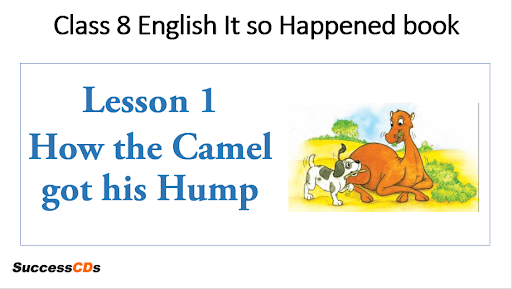
How the Camel got his hump Introduction
The story “How the Camel got his hump” by Rudyard Kipling takes us to the time when the world had just begun. At that time, the animals worked for the humans, except one lazy animal named Camel. He always said one word “Humph!” when anyone said anything to him. Due to his repeated chanting of the word “Humph!”, he ended up getting a hump (or humph) on his back, which he was earlier quite proud of. Now, he carries it everywhere and has even started working.
Video Explanation of How the Camel got his hump
How the Camel got his hump Summary
The story tells us a tale belonging to a time when the world had just begun. The animals worked for the humans. There was a Camel who lived in the middle of the desert because he did not want to work. He always said “Humph” when someone spoke to him. On a Monday morning, the Horse came to him and asked him to join the others in trotting. The Camel replied by saying “Humph!”. After a while, the Dog came to him to ask him to join the rest of them in fetching things, he said “Humph!”. Similarly, when the Ox came to him and asked him to plough like the rest of them, he replied with a “Humph!”. All three of them reported this to the Man. When the day was about to get over, the Man called the Horse, the Dog and the Ox together and told them that they’d have to work double-time because the Humph thing won’t work. The Three got angry and decided to hold a panchayat. It was only then that they found the Camel who laughed at them and said “Humph!” again and left. Shortly after that, the Djinn of all forests arrived and asked the reason behind the Three’s anger. The Horse told him about their double shifts and that the reason behind it was a lazy Camel who would not stop saying “Humph!”. The Djinn took the matter in his own hands and went to see the Camel. The Camel was looking at his reflection in the water when the Djinn found him. The Camel won’t even reply to the Djinn properly. Thus, he saw in the water that his back was puffing up. It suddenly became a hump (or humph). Upon asking, the Djinn told him that he has brought this humph over himself as a consequence of his own actions and now he should work. The Camel was confused about how he will work with a hump on his back. The Djinn told him that the humph will let him work for three days without having to eat anything. He can live on his humph. Since then, the Camel works and carries his humph (which we now call hump not to hurt his feelings) but still does not behave properly.
How the Camel got his hump- Summary in Hindi
कहानी हमें उस समय की घटना बताती है जब दुनिया अभी शुरू हुई थी। जानवरों ने इंसानों के लिए काम करना शुरू किया ।
एक ऊंट था जो रेगिस्तान के बीच में रहता था क्योंकि वह काम नहीं करना चाहता था। जब कोई उससे बात करता तो वह हमेशा “हम्फ” कहता था। सोमवार की सुबह, घोड़ा उसके पास आया और उसे दूसरों के साथ घूमने के लिए कहा। ऊंट ने “हम्फ!” कहकर उत्तर दिया।
थोड़ी देर बाद, कुत्ता उसके पास आया और उसे बाकी लोगों के साथ सामान लाने के लिए कहा, उसने कहा “हम्फ!”। इसी तरह, जब बैल उसके पास आया और उसे बाकी लोगों की तरह हल चलाने के लिए कहा, तो उसने “हम्फ!” के साथ जवाब दिया।
उन तीनों ने इसकी सूचना उस आदमी को दी। जब दिन खत्म होने वाला था, तो आदमी ने घोड़े, कुत्ते और बैल को एक साथ बुलाया और उनसे कहा कि उन्हें दो बार काम करना होगा क्योंकि हम्फ़ चीज़ काम नहीं करेगी। तीनों नाराज हो गए और पंचायत करने का फैसला किया। तभी उन्हें ऊंट मिला जो उन पर हंसा और फिर से कहा “हम्फ!” और वहाँ से चला गया।
उसके कुछ देर बाद ही सभी वनों के जिन्न पहुंचे और तीनों के क्रोध का कारण पूछा। घोड़े ने उसे अपनी दोहरी पाली के बारे में बताया और इसके पीछे का कारण एक आलसी ऊंट था जो “हम्फ!” कहना बंद नहीं कर रहा था ।
जिन्न ने मामला अपने हाथ में लिया और ऊंट को देखने चला गया । ऊंट पानी में अपने प्रतिबिंब को देख रहा था जब जिन्न ने उसे पाया। ऊंट ने जिन्न से भी ठीक से बात नहीं की। इस के उपरांत, उसने पानी में देखा कि उसकी पीठ फूल रही थी। यह अचानक एक कूबड़ बन गया। पूछने पर जिन्न ने उससे कहा कि वह इस कूबड़ को अपने कार्यों के परिणामस्वरूप अपने ऊपर लाया है और अब उसे काम करना चाहिए।
ऊंट इस बात को लेकर असमंजस में था कि वह अपनी पीठ पर कूबड़ रखकर कैसे काम करेगा। जिन्न ने उससे कहा कि कूबड़ उसे बिना कुछ खाए तीन दिन तक काम करने में मदद देगा। वह अपने कूबड़ पर जीवित रह सकता है। तब से, ऊंट काम करता है और अपने कूबड़ को ढोता है (जिसे अब हम गोलाकार ही कहते हैं ताकि उसकी भावनाओं को ठेस न पहुंचे) लेकिन ऊंट फिर भी ठीक से व्यवहार नहीं करता है।
How the Camel got his hump- Lesson Explanation
Passage – In the beginning, when the world was new and the Animals were just beginning to work for Man, there was a Camel, and he lived in the middle of a Howling Desert because he did not want to work. He ate sticks and thorns and prickles, and when anybody spoke to him he said “Humph!” Just “Humph!” and no more.
Word Meaning:
Howling Desert- a desert where you hear howling noises of both animals and the wind
Thorns– a stiff, sharp-pointed woody projection on the stem or other part of a plant
Prickles– a short pointed outgrowth on the bark or epidermis of a plant; a small thorn
Explanation of the Above Passage – When the world had just begun and the animals had just started working for humans, there was one lazy Camel who did nothing and said nothing except “Humph” whenever anyone spoke to him. He lived in the middle of a Howling Desert because he had no intention of working. He fed himself on sticks, thorns and prickles.
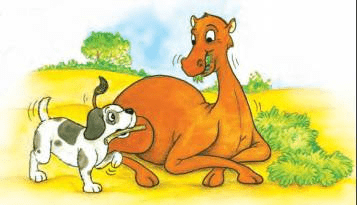
Passage – Presently the Horse came to him on Monday morning, with a saddle on his back and said, “Camel, O Camel, come out and trot like the rest of us.” “Humph!” said the Camel, and the Horse went away and told the Man. Presently the Dog came to him, with a stick in his mouth, and said, “Camel, O Camel, come and fetch and carry like the rest of us.” “Humph!” said the Camel, and the Dog went away and told the Man. Presently the Ox came to him, with the yoke on his neck, and said, “Camel, O Camel, come and plough like the rest of us.” “Humph!” said the Camel, and the Ox went away and told the Man.
Word Meaning:
Saddle– a seat fastened on the back of a horse or other animal for riding, typically made of leather and raised at the front and rear
Trot– run at moderate pace with short steps
Fetch– go and then bring back (something) for someone
Yoke– a wooden cross piece that is fastened over the necks of two animals and attached to the plough or cart that they are to pull
Plough– turn up the earth of (an area of land) with a plough, especially before sowing
Explanation of the Above Passage – One monday morning, the Horse visited the Camel with a saddle on his back and asked him to trot like everyone else. The Camel replied by saying “Humph!”. The Horse went to the Man and reported this to him. Similarly, the Dog came to the Camel with a stick in his mouth and asked the Camel to come and bring back things like them. The Camel again replied with a “Humph!”. The Dog told all this to the Man. Then again, the Ox went to the Camel with a yoke on his neck and asked him to plough like the rest of them. Not surprisingly, the Camel replied to the Ox with a “Humph!”. The Ox, like the other two, went to the Man and told him everything.
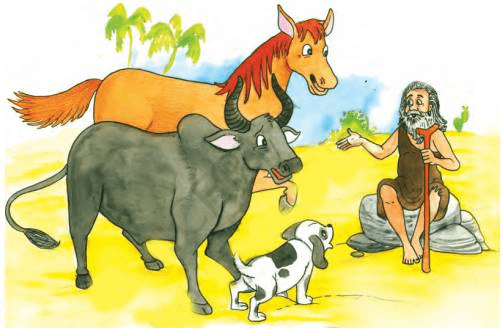
Passage – At the end of the day the Man called the Horse and the Dog and the Ox together, and said, “Three, O Three, I’m very sorry for you; but that Humph-thing in the Desert can’t work, or he would have been here by now, so I am going to leave him alone, and you must work double-time to make up for it.”
Explanation of the Above Passage – At that particular day’s end, the Man called all three of them (the Horse and the Dog and the Ox) together. He told the three that he felt sorry for them as they would have to do the work all by themselves and would have to double their shifts for completing it. They would have to do this because the “Humph-thing”, which was the Camel can’t work or else, he would have been there with them.
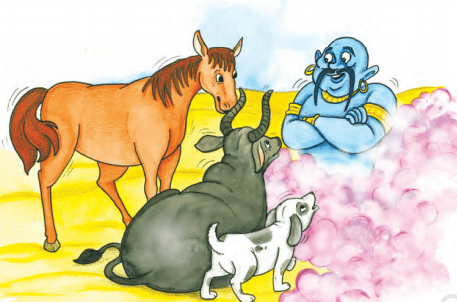
Passage – That made the Three very angry, and they held a panchayat on the edge of the Desert; and the Camel came chewing cud and laughed at them. Then he said “Humph!” and went away again. Presently there came along the Djinn who was in charge of All Deserts, rolling in a cloud of dust.
“Djinn of All Deserts,” said the Horse, “is it right for anyone to be idle?”
“Certainly not,” said the Djinn.
“Well,” said the Horse, “there’s a thing in the middle of your Desert with a long neck and long legs, and he hasn’t done a stroke of work since Monday morning. He won’t trot.”
“Whew!” said the Djinn whistling, “that’s my Camel. What does he say about it?”
“He says ‘Humph!’, and he won’t plough,” said the Ox.
“Very good,” said the Djinn. “I’ll humph him if you will kindly wait a minute.”
Word Meaning:
Panchayat– a council
Cud– partly digested food returned from the first stomach of ruminants to the mouth for further chewing
Djinn: (pronounced ‘jin’ and variously spelt as ‘genie’, ‘genii’, ‘jinnee’, ‘djinni’, ‘djinny’): a spirit that has strange powers and can assume any form, human or animal
Whew– used to express surprise
I’ll humph him: I’ll deal with him appropriately./I’ll set him right.
Explanation of the Above Passage – Upon hearing that, they would have to work double-time, the Three got annoyed. They conducted a panchayat on the border of the Desert. Only then, the Camel arrived chewing cud. He made fun of the Three, said his regular “Humph!” and left.
The very next moment, the Djinn of All Deserts arrived rolling in a cloud of dust. The Horse asked the Djinn if it was okay for someone to spend all their time doing nothing. The Djinn said it was not right. The Horse further gave him a description of the Camel and told him that a creature with a tall neck and long legs who lives in the centre of the Desert had not done work since Monday morning and that he won’t even trot. The Djinn was quite surprised on hearing this and tells the Three that he knows the Camel and asks them about his attitude towards work. The Ox told him that he does not even plough and only says “Humph!” whenever they go and talk to him. The Djinn understood and took the situation in his hand and asked the Three to wait till he handled the Camel.
II
Passage – The Djinn rolled himself up in his dust-cloak, and took a walk across the Desert, and found the Camel looking at his own reflection in a pool of water. “My friend,” said the Djinn, “what’s this I hear of your doing no work?” The Djinn sat down, with his chin in his hand, while the Camel looked at his own reflection in the pool of water.
“You’ve given the Three extra work ever since Monday morning, all on account of your idleness,” said the Djinn.
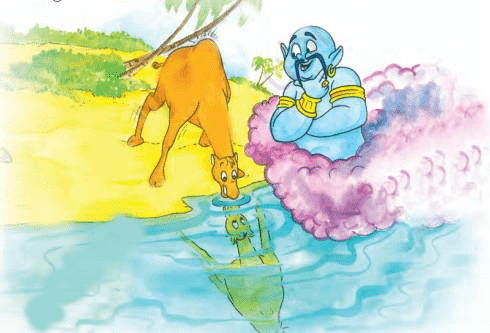
Explanation of the Above Passage – After having a word with the Three, the Jinn disappeared by rolling himself in his dust-cloak. He walked around in the Desert to find the Camel. He finally found the Camel gazing at his own reflection in the water. The Djinn told the Camel that he had heard of him not willing to work at all. The Camel continued to look at his own reflection while the Djinn sat down with his chin in his hand. The Djinn continued to speak as he told the Camel that as a consequence of his laziness, the Horse, the Dog and the Ox are working double time since Monday morning.
Passage – And he went on thinking with his chin in his hand.
“Humph!” said the Camel.
“I shouldn’t say that again if I were you,” said the Djinn; “you might say it once too often. I want you to work.”
And the Camel said “Humph!” again; but no sooner had he said it than he saw his back, that he was so proud of, puffing up and puffing up into a great big hump.
Word Meaning:
Puffing up– becoming bigger
Hump– a rounded protuberance found on the back of a camel or other animal
Explanation of the Above Passage – After talking to the Camel clearly, the Djinn continued his thinking. The Camel replied with his usual “Humph!”. The Djinn told the Camel to better stop saying it. He added that he had been saying “Humph!” quite a lot now and how he wants him to start working instead.
Despite Djinn’s warning, the Camel replied again with a “Humph!”. As he took out the word out of his mouth, the Camel noticed his back becoming bigger and bigger. The back he was so obsessed with had now grown up into a big hump.
Passage – “Do you see that?” said the Djinn. ‘‘That’s your very own humph that you’ve brought upon your very own self by not working. Today is Thursday, and you’ve done no work since Monday, when the work began. Now you are going to work.”“How can I,” said the Camel, “with this humph on my back?”
‘‘That has a purpose,” said the Djinn, “all because you missed those three days. You will be able to work now for three days without eating, because you can live on your humph; and don’t you ever say I never did anything for you. Come out of the Desert and go to the Three, and behave.”
Explanation of the Above Passage – The Djinn mentions that the bulge on his back is his humph and it is a result of his own actions. It was Thursday and the Camel hadn’t done a single thing since Monday, when all the work began. The Djinn clarifies that now the Camel has to work.
The Camel, after seeing the hump, asked Djinn how can he work with something like that on his back. The Djinn replied that the humph served a purpose. It will enable him to work for three days (because he did no work for the first three days) without eating anything. Djinn said that he can live on his humph. He further goes on to say that the Camel better not point out that the Djinn never did anything for him. He asked him to get out of the Desert and begin working with the Three.
Passage – And the Camel went away to join the Three. And from that day to this the Camel always wears a humph (we call it ‘hump’ now, not to hurt his feelings); but he has never yet caught up with the three days that he missed at the beginning of the world, and he has never yet learned how to behave.
Explanation of the Above Passage – The Camel joined the Three to work with them. Since that day, he always carries his humph along, which we now call “hump” to not hurt his feelings. Despite working, he has not been able to compensate for the first three days when the world began. Also, he did not learn to behave properly.
How the Camel got his hump- Question and Answers
1. What tasks, do you think, were assigned to the dog and the ox?
A. The Dog was assigned the task of fetching and carrying while the Ox on the other hand was asked to plough.
2. Why did the camel live in the middle of the desert?
A. The Camel had no intention of working. Thus, he lived in the middle of the desert where everything is in abundance.
3. What made the dog, the horse and the ox very angry?
A.Upon realising that the Camel won’t work at all, the Man told the Dog, the Horse and the Ox that they would have to do all the work themselves. For that, they would have to work double-time for that. This made the Three very angry.
4. How did the Djinn know the horse was complaining against the camel?
A. The Djinn was in charge of all the deserts. Thus, when the Horse gave a description of the Camel, that he had long neck and long legs, the Djinn could easily identify that he was talking about the Camel.
5. The camel was looking at his own reflection in the pool. What does it suggest to you about the camel?
A. The Camel was looking at his own reflection in the pool. This shows that he was quite proud of his looks, especially his back.
6. The camel said, “Humph” repeatedly. How did it affect him?
A. As a result of his repeated reply “Humph!”, he ended up having a puffed up back. He was quite proud of his back that had now turned into a big hump. The hump will now help him to work for three days (because he did not work for the first three days on earth) without eating anything.
7. What, according to the Djinn, was the use of the “humph”?
A. According to the Djinn, the puffed up “humph” on the back of the Camel would let him work for three days straight (because he did not work for the first three days on earth) without having to eat anything. The Camel could now live on his hump (or humph).
8. “…he has never yet learnt to behave”. In the light of this, what is the writer’s opinion about the camel?
A. The writer’s opinion of the Camel remained the same as it was in the beginning of the story. The Camel is still a lazy animal who had failed to compensate for the first three days he missed working. He still makes fun of others. Thus, the writer has said, “…he has never yet learnt to behave”.
Conclusion
In the above post, we have provided details of Lesson 1 from It So Happened, the NCERT book for Class 8. Chapter 1 is titled How the Camel Got His Hump. You can find the summary, a detailed line-by-line explanation of the passage, the meanings of difficult English words, and important question-and-answer sections from this lesson. We hope you found it helpful. For any suggestions or feedback, please feel free to leave a comment below this post.
Also See :
It so Happened Book Lessons
- Children at work, Class 8 CBSE English Lesson Summary, Explanation<
- The Selfish Giant, Class 8 CBSE English Lesson Summary, Explanation
- The Treasure Within, Class 8 CBSE English Lesson Summary, Explanation
- Princess September, Class 8 CBSE English Lesson Summary, Explanation
- The Fight, Class 8 CBSE English Lesson Summary, Explanation
- The Open Window, Class 8 CBSE English Lesson Summary, Explanation
- Jalebis, Class 8 CBSE English Lesson Summary, Explanation
- The Comet-I, Class 8 CBSE English Lesson Summary, Explanation
- The Comet-II, Class 8 CBSE English Lesson Summary, Explanation
- Ancient Education System of India Class 8 Summary, Explanation
Honeydew Book Lessons
- Class 8 English Chapter 1 The Best Christmas Present in the World notes
- The Tsunami Class 8 English Chapter 2 Explanation, Question Answers
- Glimpses of the Past Class 8 English Chapter 3 Explanation and Summary
- Bepin Choudhury’s Lapse of Memory Class 8 English Chapter 4
- The Summit Within, Class 8 CBSE English Lesson Summary, Explanation
- This is Jody’s Fawn, Class 8 CBSE English Lesson Summary, Explanation
- A Visit to Cambridge, Class 8 CBSE English Lesson Summary, Explanation
- A Short Monsoon Diary Class 8 Summary, Explanation, difficult words
- The Great Stone Face-I, Class 8 CBSE English Lesson Summary, Explanation
- The Great Stone Face-II, Class 8 CBSE English Lesson Summary, Explanation
Honeydew Book Poems
- The Ant and the Cricket, Class 8 CBSE English Poem Summary, Explanation
- Geography Lesson, Class 8 CBSE English Poem Summary, Explanation
- Macavity: The Mystery Cat, Class 8 CBSE English Poem Summary, Explanation
- The Last Bargain, Class 8 CBSE English Poem Summary, Explanation
- The School Boy, Class 8 CBSE English Poem Summary, Explanation
- When I set out for Lyonnesse, Class 8 CBSE English Poem Summary, Explanation
- On the Grasshopper and Cricket, Class 8 CBSE English Poem Summary, Explanation